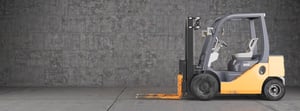 A forklift buying decision is a big one for any operation. While a variety of factors play into what makes for the perfect forklift, these three requirements should help you narrow your decision down to the type of forklift you need:
A forklift buying decision is a big one for any operation. While a variety of factors play into what makes for the perfect forklift, these three requirements should help you narrow your decision down to the type of forklift you need:
1. Forklift Application
To the layman, it may seem like a forklift is a forklift, but that’s definitely not the case. A general warehouse has needs that are very different from freezer or food storage needs. Different forklifts are needed depending on the job at hand.
For example, consider retail versus lumberyards. The former requires a forklift suitable for indoor use, while the latter requires one appropriate for outdoor exposure. From general manufacturing to specialty applications like beverage and oil/gas, your application will play a large role in choosing a forklift.
Key drivers include: number of pallets moved per hour, number of shifts, hours worked per shift, weight and shape of load, special attachments needed and environmental factors (cold storage, hot ambient temperature).
2. Space Requirements for Various Types of Forklifts
The application will also have a direct bearing on your operation’s space requirements. Let’s use a warehouse environment as an example. A warehouse can be configured a variety of different ways. Often, aisle dimensions alone will determine whether you need a sit-down rider, narrow aisle, turret, or double-reach forklift. Before making such a significant investment, it’s critical to measure these dimensions with precision to ensure maximum efficiency.
3. Forklift Terrain
There’s a huge difference between a warehouse floor and outdoor terrain. Beyond the fact that the lift requirements on a construction site will differ from those of a warehouse, dealing with loose dirt or gravel is also a game-changer. Ground clearance becomes more important. Indoor versus outdoor usage can also dictate whether you use propane or electric trucks, as well as whether or not you need forklifts with pneumatic, rubber, or polyurethane tires.
Now You Can Really Start Shopping
The range of forklift options can be intimidating; however, once you have the answers to the above questions, it makes it easier to whittle down this list:
- Electric Pallet Jacks
- Pallet Stackers
- Electric Forklifts
- Propane Forklifts
- Reach Trucks
- Turret Trucks
- Rider Pallet Trucks
- Tuggers
- Order Pickers
Some operations only need one kind of lift truck, while others require multiple. In the end, each operation is different, and the application, space requirements, and terrain will help you make the best forklift decision possible.
To learn more about how to make this important decision for your motive operation, download our Forklift Partner Evaluation Scorecard.


 Ryan Lynch
Ryan Lynch